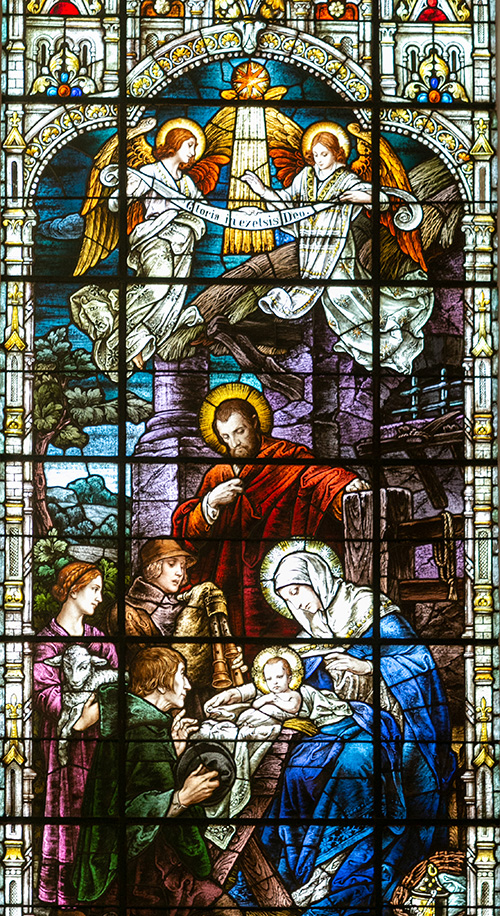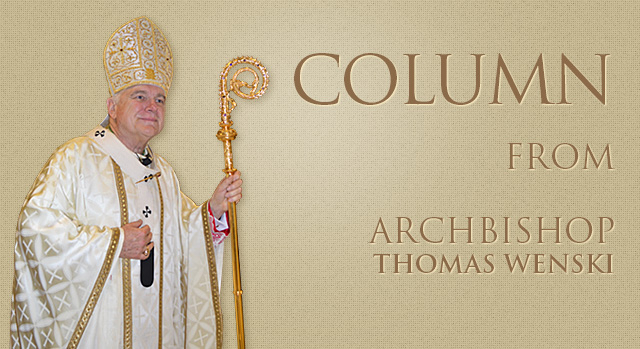By Archbishop Thomas Wenski - The Archdiocese of Miami

Photographer: ANA RODRIGUEZ-SOTO | FC
Stained glass image of the Nativity at Gesu Church in downtown Miami. Cover of December 2019 edition of Florida Catholic, Miami.
In Luke’s Gospel, the angel tells the shepherds: “You will find a babe wrapped in swaddling clothes and lying in a manger.” (Luke 2:12) They say that a picture speaks a thousand words. And in church art, icons are drawn in such a way so to speak the Word of God through the signs and symbols represented through the artist’s talent. During the Christmas season, our attention is drawn to the crèche. The crèche, no matter how elaborate or simply made, is the foremost “icon” of Christmas that speaks across the ages and across cultures and tells us of “glad tidings.”
Today the crèche has been widely banished from public display — whether in our cities’ parks or even on the private property of our shopping malls. Nevertheless, in thousands of churches — from great basilicas to humble rural chapels — a crèche enhances the usual liturgical décor. Even many of our Protestant brethren, who normally tend to be iconoclastic, proudly have in their places of worship a crèche which originated with a Catholic saint, Francis of Assisi.
On Dec. 1, the first Sunday of Advent, Pope Francis visited a small village, Greccio; it was there that St. Francis displayed the first nativity scene. During this visit, the pope issued an Apostolic Letter, Admirabile Signum, on the meaning and importance of the crèche, which he encouraged be displayed not only in homes and churches but also in public places. “Beginning in childhood, and at every stage of our lives,” the Holy Father recalled, “it (the nativity scene) teaches us to contemplate Jesus, to experience God’s love for us, to feel and believe that God is with us...”
We see the animals, the poor shepherds, we see the mother who has just given birth. We see the awestruck yet protective Joseph. And we see the baby, placed in a feed box — a manger. Who could imagine that this little baby is the Son of the Most High? Only she — his Mother — does. Looking at her newborn baby with the eyes of faith, Mary knows the truth and guards the Mystery. Today, we can also join in her gaze, and look on this child through her eyes — through those eyes of simple and unwavering faith — and so recognize in this child the human face of God.
As the pope writes in his letter, “In a particular way, from the time of its Franciscan origins, the nativity scene has invited us to ‘feel’ and ‘touch’ the poverty that God’s Son took upon himself in the Incarnation. Implicitly, it summons us to follow him along the path of humility, poverty and self-denial that leads from the manger of Bethlehem to the cross. It asks us to meet him and serve him by showing mercy to those of our brothers and sisters in greatest need (cf. Mt 25:31-46).”
In this way, Christmas becomes a real school of faith and life, a training ground for us, in turn, to learn the truth and become with Mary guardians of the Mystery that Christmas proclaims. She was the first disciple because she first heard the Word and obeyed it. Thus, she is rightly regarded by all generations as blessed amongst women. In this school of faith and life which is Christmas, we too can become like Mary and assume the risks and the joys of discipleship.

